Annie May STERRY (nee BAILEY), Civilian
Killed by a V-2 rocket at Hoffmann’s factory, Rectory Lane, Chelmsford. Aged 38
Annie May Bailey was born in Suffolk in 1906, married there in 1923, and had a child the following year. In late 1944 the family were living in New Street, Chelmsford and Annie was working at Hoffmann's bearings factory in the town. She was killed at the factory in December 1944 when a German V-2 rocket exploded adjacent to the factory.
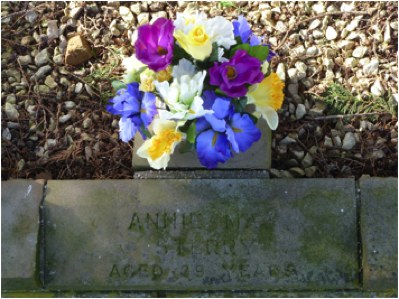
Annie was born in Suffolk in 1906, the daughter of Burton Bailey (1879-1921) and Annie Burton (nee Hazelwood) (1881-1970). Her parents had married at St. James' Church in Icklingham on 24th July 1905. At the time her father was a stockman.
Annie's siblings were: Lilian Ethel Bailey (1907-1994), Thomas George Burton Bailey (1910-1911), John Watson Bailey (1911-1911), Gertrude Mary Jane Bailey (1914-1945), Elsie Irene Bailey (1917-1918), and Albert Edward Bailey (1919-2003).
In 1921 Annie's father committed suicide by drowning himslef in a pond at Great Ashfield in Suffolk.
In 1923 Annie married James Sterry in Suffolk. The couple had a son, born the following year.
In 1944 Annie and her husband were living at 29 New Street in Chelmsford, and Annie was working at the town's Hoffmann's ball-bearings factory. The factory was a prime target for German air raids and factory workers had been killed there in two separate raids in 1942, but the worst incident at the factory occurred two years later.
At 1.28 a.m. on 19th December 1944 a German V-2 rocket fell close to Hoffmann's factory, causing the town’s greatest loss of life from a single wartime incident.
The bomb dropped on a building in which, only a quarter of an hour before, men women, and girls had been singing Christmas carols to the accompaniment of a Salvation Army Band. The band had left the building when the crash came, but they returned and helped with the rescue work/ Many people were still humming the familiar Christmas tunes. Everybody was happy. Then came chaos.
People were trapped and several were killed. Several houses and buildings were damaged. One of the girls who escaped had been living in the area where the bomb fell for only a week. 'We were singing' she said, 'when the place was filled with flames. Debris was falling everywhere, and all the lights went out. I remember I was singing the line 'You make me happy'. 'In the confusion I also remembered where I had left my torch. It was still there, although the lathes and all the workshop fittings had been blown all over the place. I grabbed two friends who were working beside me, and somehow we scrambled out if a gap in the wall which had once been the entrance to the shop.' The girl's eyebrows and hair were singed from the heat of the blazing rafters which had crashed and were setting fire to the oil on the workshop floor. 'The heat was the most terrifying thing as we scrambled out. I don't really remember hearing a bang when the bomb exploded. I am certain we got out only because we were working at the end of the shop nearest the entrance. Behind us we could hear the other girls screaming for help as they tried to scramble through the flames.'
Ambulance and Civil Defence Services operated promptly, and American soldiers helped in the rescue work. Some of them took homeless people to their camps in jeeps. Much gratitude is being expressed to the Americans. Two American soldiers were seen by a warden inside a burning house, part of which was in danger of collapsing. They had obtained a stirrup pump from somewhere, and were trying to put out the fire. they would not give up.
A little girl taken to hospital with her parents, asked first, after she had been put to bed, 'Have they saved my Christmas tree?'.
Rescue work went on for several hours aided by searchlights. The work was greatly hampered by a fire which broke out soon after the bomb had fallen.
One girl owes her life to the death of her father. He died the morning before, so the girl stayed at home with her mother. In ordinary circumstances she would have been in the building with her friends, one of whom was killed and the other seriously injured.
A man who was twice bombed out at Deptford and removed himself and his family to the town, was expecting all his relatives from London for 'a nice quiet Christmas'.
On the afternoon after the bomb fell he was searching in the ruins of his house for his Christmas dinner, Ruefully he said: 'I had chickens and all in there. I was going to give them a slap-up do. But I saved the beer/'
Triumphantly he held up half a dozen quart bottles covered with dust, their labels torn off, but their contents intact. 'Perhaps this will put a little life in us' he said. An assistant who worked in the building, but had not gone on duty that night had a narrow escape, She was is bed when the side wall of the house caved in on her, She was got out unhurt. A domestic argument saved two inhabitants. 'I had a premonition that I should not sleep upstairs that night', said the husband. 'My wife said it was all nonsense. and we were still arguing where we should sleep when the bomb fell. We were in the front room downstairs.' That room is all that remains of their home.
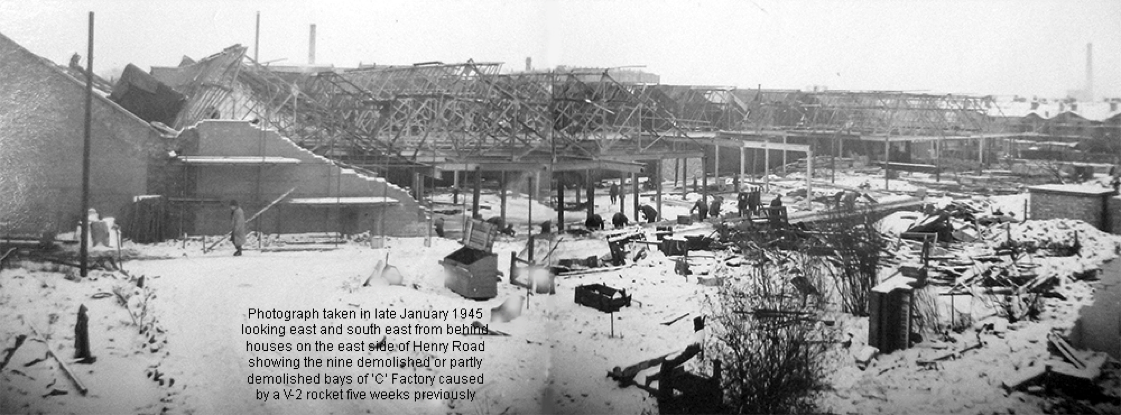
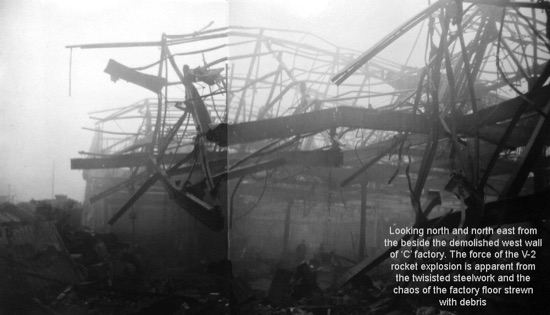
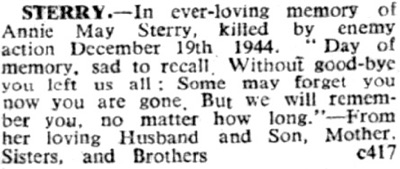
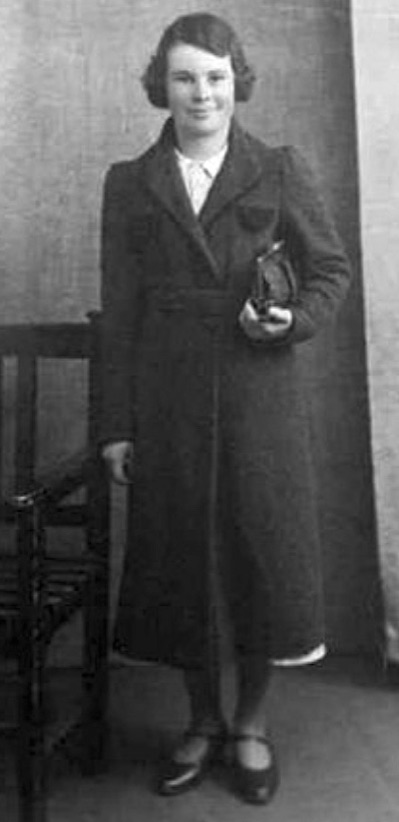
Among the dead was 38 year-old Annie.
Official figures put the total fatalities of the V-2 incident at 39 dead and 138 injured, including 47 seriously so. Thirty of the dead were workers on the night shift at Hoffmann’s, including ten men, nineteen women and one unidentified body, the majority killed in the fire that the rocket started. Nine others died in Henry Road.
The V-2 struck the extreme western edge of the roof of Hoffmann’s C Factory’s Cage & Assembly Department, which fronted Rectory Lane, approximately level with the garden of 11 Henry Road which runs off the northern side of Rectory Lane. The rocket exploded before reaching the earth bank which ran alongside the outer west wall of the factory, leaving a small crater, 12 feet across by 6 feet deep.
The blast devastated a large area of Hoffmann’s, demolished several properties in Henry Road and damaged hundreds of others in the town. More importantly it claimed the lives of thirty Hoffmann’s employees and a further nine of Henry Road residents.
At Hoffmann’s the night shift had just returned to their benches and machines to continue their work after singing Christmas carols to the accompaniment of the visiting Salvation Army band. Spirits had been high with the end to the war at last in sight and the festive season already begun.
Many of the workers were young women who were still singing when without any warning the V-2 exploded yards away from them. In an instant the blast swept across the factory and neighbouring streets with devastating consequences.
The worst affected part of the factory was that closest to the explosion - the Cage & Assembly Department. It was housed in a single-story, north light roofed building, 514 feet long by 81 feet wide, running parallel to and behind houses on the eastern side of Henry Road. The term ‘north light’ describes a type of factory building, designed so that windows incorporated into the vertical faces of its saw-tooth roof can allow the maximum amount of natural light into its interior.
A considerable length of the Department’s external western wall and a smaller internal wall which divided it from the Turret Department were immediately demolished by the blast, along with a paraffin washing plant and various shelters and internal steel and timber partitions. The entire north light-type roof of C Factory was stripped of its poilite sheeting (a type of asbestos cement product), slate and asbestos covering and the roof structure displaced. Stanchions and girders near the crater were wrenched apart and badly twisted and several air raid shelters built against the outside wall were demolished. The neighbouring Turret Department suffered no serious damage except that to its roof which was moved some eight inches eastwards through its gable ends, whilst the roofs of A and B Factories were also considerably damaged by the blast.
A split second after the blast damage, a ferocious fire was started in bays 1 to 10 of the Cage & Assembly Department when a 200 gallon tank of paraffin was ignited by the explosion - either through an electrical short circuit when cables were damaged or sparks from falling steelwork. The paraffin tank was part of a bearing washing plant, partly housed in a brick and concrete building and partly enclosed by steel partitions and was situated some sixty feet from the impact point of the V-2. Burning paraffin was distributed over wooden benches, boxes, timber partitions and debris that had already been wrecked by the blast.
Within a minute of the explosion fire watchers at Hoffmann’s had informed the works fire brigade of the fire and two pumps were immediately ordered to deal with it - one from the River Chelmer at Mill House and the other to C Factory Engine Room to boost the fire mains. On their arrival at the fire the works brigade found that there was only low pressure on their hoses from the factory mains and then discovered that the overhead mains had been fractured by blast and debris. The pump at the C Factory Engine Room was then ordered to ‘knock off’ and get to work from the River Chelmer near the factory’s gas plant. By 1.29 a.m. it was clear that outside help would be necessary and a call for assistance was telephoned through to the National Fire Service. It sent four pumps to the incident, with the first arriving at 1.32 a.m. They were got to work from the hydrant in Rectory Lane and a static water tank in Henry Road which was supplied by a stationary pump from Mill House.
Within minutes other civil defence staff were on the scene, aided by considerable numbers of American servicemen from Boreham Aerodrome and members of the returning Salvation Army Band.
At 1.50 a.m. a pump and crew arrived from Marconi’s and got to work from the River Chelmer at the side of the works fire station. In addition to these seven pumps hoses were also put into action from three fire hydrants in the factory, enabling the blaze to be tackled from all directions.
At 2.12 a.m. the Essex Police H.Q. received its first casualty report from Hoffmann’s. It spoke of being inundated with victims. Five minutes later the A.R.P. authorities, aware that the incident was of a very serious nature, called for mutual assistance from neighbouring districts. Their response was magnificent and the next few hours would see the arrival of additional ambulances, rescue squads, first aid parties, heavy lifting equipment and canteen facilities from other parts of Essex. Rest centres were quickly opened in Chelmsford for the bombed out and some of the homeless were driven to Boreham Aerodrome by the Americans.
As rescue work continued against the backdrop of the large fire so the number of reported casualties began to rise.
At 2.50 a.m. one person was said to have been killed, four were missing and 52 were slightly injured. Twenty-eight minutes later, almost two hours after the explosion, Column Officer Bowden of the N.F.S. rang his superiors at the Market Road Fire Station and reported that no further pumps were needed as the fire was now under control.
At 4.32 a.m. the Marconi’s pump was sent back to its base and eight minutes later the updated casualty list read ‘ten dead, over 100 injured with more believed hurt’. Ten minutes after that the fire was finally extinguished. One pump was kept standing by until 11.30 a.m. and raking over continued until mid day. By that time casualties spoke of ‘approximately 20 dead and over 100 injured at Hoffmann’s’. As recovery of the victims continued during daylight the number of confirmed fatalities continued to rise to eventually number thirty.
The majority them were thought to have been caused either by being struck by falling debris or by being thrown by the blast against some object. However, many of the victims had subsequently been burned in the fire. Chief Fire Officer D. Ricketts later reported that he had personally retrieved two charred bodies and placed them in to blankets prior to their removal, and that he was convinced that their deaths had been not through the fire but by being blasted against air raid shelter 28c. Annie’s body was removed to the wartime emergency mortuary established at the former race course grandstand at Galleywood Common.
In the morning following the incident the scene was inspected by Regional Commissioner, accompanied by the Mayor and County A.R.P. Controller. They gave the highest praise to all those who took part in the difficult, hazardous and harrowing task of rescuing the casualties and removing the remains of the victims of the V-2.
Most of the damaged roofs at Hoffmann’s, except for those in the immediate vicinity of the explosion, were covered with poilite sheets and tarpaulins within 36 hours to prevent weather damage - an impressive task given the size of the job. Morale of those involved in the repairs and cleaning up operations was said to have remained good and determined.
The first and last stages of production were most disrupted in the incident, though all but 17 machines escaped serious damage and were subsequently moved to other parts of Hoffmann’s to be working within a few days. Work in more distant parts of the factory was able to continue practically unaffected. After clearance of the site rebuilding work would subsequently start on 17th January 1945. The incident was to have serious financial implications on Hoffmann’s. Its annual profits would shrink from £217,930 in 1943-4 to just £77,608 for the following financial year.
News of the V-2 incident was reported by the Essex Chronicle in its edition on 22nd December 1944:
"Singing girls among V-Bomb victims. Americans give grand rescue aid.
Christmas decorations, a teddy bear, a shattered doll, and part of a Christmas tree were among the pathetic assortment of articles that were left strewn about the roads after a V-bomb had fallen in a town in Southern England recently.
For some time after the incident children in some houses were still trying to salvage toys and Christmas presents. Ten year-old Joyce Green and her brother John were searching for a powder compact. 'We saved our pocket money for two months to buy it for mummy for Christmas. and now it has gone', Joyce said.
While search went on in the wrecked shop for missing workers work continued as usual in the other departments.
Rest centres were opened in different parts of the town and W.V.S. and officials from the Food Office provided food on the spot, A number of people were 'bombed-out' for the third time, 'No Christmas at home for us this year', said one of them, Mrs. Radley. ' We had our two Army sons and a daughter who is in the W.A.A.F. home with us. We were going to have a jolly time. Now it won't be so jolly.'"
A memorial service was held at Chelmsford Cathedral four days later for the victims of the V-2 rocket. It attracted a large congregation including representatives and survivors from Hoffmann’s, the Home Guard, Police, Civil Defence Services and local dignitaries.
On 29th December 1944 nineteen of those killed at the factory, including Annie, were buried in a communal grave at Chelmsford Borough Cemetery with the service conducted by by the Provost of Chelmsford Cathedral, the Very Rev. W. E. R. Morrow.
That day the the Essex Weekly News reported:
Died at post of duty. Service for V-bomb victims. A communal grave.
Today (Friday) in a common grave in a South of England cemetery, there will be buried some of the victims of a recent tragedy, when a V-bomb fell near a building in which night workers were employed.
During last weekend a memorial service in connection with the same incident was attended by the Mayor and members of the Corporation of the town, and the large congregation included a number of the directors of the firm whose employees were among the dead.
Clergymen representing various denominations took part in the service. In a pulpit reference to the occasion, one of the officiating clergy said: 'It is difficult to express through the rigid medium if words all the thoughts and emotions we feel at such a time as this. Our hearts go out in loving sympathy to those who, through a ruthless enemy, are left to face life alone without husband or father. We all deeply mourn wit them their loss. But through the dark clouds of tragedy there is breaking the dawn of victory to which their lives will have contributed. Weeping may endure for a night, but joy cometh in the morning. When the bells and trumpets herald the victory their names will live again in the afterglow if fame. There is another feature which our service today commemorates. It is the glory if these beloved dead - that they died at the post of duty. They had that faith in winning of the war that right makes might, and in that faith they dared to do their duty to the end. They are realising now the reward that God had awaiting them, and the path of duty passed their way to glory. No joy is there in earth more pure than this. No sweeter foretaste of celestial bliss than when one rests beneath life's setting sun and says 'It was my duty and is done'.'
'And so my dear friends', he concluded. 'as we leave our comrades sleeping - we sorrow, but not as those without hope. Memory shall ever remain as an inspiration to everyone of us to follow them in the path of duty."
On Friday 5th January 1945 the Essex Chronicle reported:
"In one grave, V-Bomb victims lie side by side. Profoundly moving were the scenes in the cemetery of a town in Southern England, when victims of a recent V-bomb incident were buried side by side in one grave.
Crowds of people gathered outside the cemetery gates. The long procession to the grave was headed by the local Salvation Army, which plated appropriate music at slow march. The standard-bearer carried the 'Army' flag, which was surmounted by white ribbon streamers. Most of the mourners carried flowers. Bereaved mothers had to be supported by friends.
The band played 'Promoted to Glory'. Facing the procession as it approached the grave was a flagstaff with the Union Jack at half-mast. There were Union Jacks, too, on the walls of the grave.
The mourners gathered around the grave, facing and close to the surpliced clergy. The band, on a grass 'island' near by, had ceased playing. Away in the distance an aircraft wove a vapour trail in the sky. The winter sun cast a slanting ray across the green-covered bank. Then from the Rector came the words of the Burial Service: 'I am the resurrection and the life, saith the Lord; he that believeth in Me, though he were dead, yet shall he live.....". Prayers followed. Then a few homely words to the sorrowing ones: - We are proud of them. We shall not forget their sacrifice. They thought not of themselves. We commend them to God's loving care....and He too will comfort you who sorrow.
Then the voice of a Roman Catholic priest, and the responses of his curates. More prayers; and finally the Benediction.
The mourners began to move slowly around the grave. They dropped flowers on the coffins. Softly the band started to play again. Men as well as women wept openly. A lad in khaki and another in R.A.F. blue supported a woman by the arms. And the pilgrimage went on, while the clergy went to console little groups of mourners."
The workers killed at Hoffmann’s in the V-2 rocket incident were:
Leonard Charles Bailey Vera Joan Baker Winifred Margaret Edith Boyce Henry John Brown Cissie Alice Devenish Edward David Driscoll Phyllis Maude Evans Edith Annie Everitt Harold Lionel Foley Constance Esther Franklin Dorothy Maud Hancock Emily Kate Harvey Charles Frederick Hollis Lilian Grace Horne Arthur Edmund Jackson Winifred Joan Johnson Muriel May Mullender Joan Munson Catherine Murphy Leonard George Outten Muriel Jean Outten Joyce Dorothy Phillibrown Edith Maud Piper Marjorie Lily Scott Arthur Seager Annie May Sterry Alfred William Stuart-Smith Barbara Olive Thorogood William Alfred Thorpe Unknown Person
In November 1945 Annie's sister, Gertrude, was found drowned in shallow water near Admiral's Park in Chelmsford. In teh inquest that followed a verdict of suicide was recorded.
On the second anniversary of the incident a memorial garden was dedicated by the Chelmsford Cathedral Provost at the communal grave in the Borough Cemetery, designed by a member of Hoffmann’s’ staff. Memorial services were also held at Chelmsford Cathedral and London Road Congregational Church and a memorial plaque to the victims was unveiled in the factory’s canteen. The memorial garden includes the following inscription:
"This garden is dedicated to the memory of 29 employees of the Hoffmann Manufacturing Company Limited, 19 of whom lie in this grave, who were killed by enemy action on 19th December 1944; and to the memory of 7 employees who were killed by enemy action on 19th July 1942 and 19th October 1942. They shall remind faith the Lord of hosts in that day when I make up my jewels."
150126